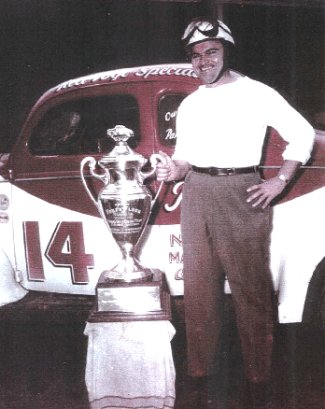
Brandon Reed
By Brandon Reed
Posted in Columns 4/30/10
Tony Stewart was in the Peach State this past week, turning test laps at the redesigned Gresham Motorsports Park in Jefferson, Georgia, along with two other Sprint Cup teams.
Stewart was impressive as he turned laps in his Chevrolet, which is usually adorned with the number 14. On this day, the Chevy Stewart was piloting had no numbers or decals.
Stewart has piloted the number 14 for the last season and a half. He announced he’d race under that number when he announced his buy-in to the as part owner to what was then Haas-CNC Racing.
The reason Tony went with this number was his connection to one of his racing heroes, legendary racer A.J. Foyt.

Driving the number 14 Ford for Raymond Parks, Fonty Flock won the 1947 NSCRA championship, which one year later would become NASCAR.
While Foyt is synonymous in racing with the number 14, the man who had the most success in NASCAR with that number was Georgia Racing Hall of Fame member Fonty Flock.
Born in 1921 in Ft. Payne, Alabama, Truman Fontello Flock, better known as Fonty, was the middle of three brothers who would become racing legends. Older brother Bob was an incredible modified racer, and younger brother Tim would go on to be one of NASCAR’s 50 greatest drivers.
Fonty ran his first race at the legendary Lakewood Speedway in Atlanta in 1939, and won his first career race at that same track one year later.
In 1941, Fonty traveled to Daytona Beach for the annual beach race, taking the pole for the event.
While racing with fellow Georgian Roy Hall, the two made contact in the south turn, sending Fonty’s car out of control, and end over end.
Fonty’s seatbelt broke during the accident, and he came away with multiple injuries, including a crushed chest.
Fonty returned to racing in 1947 in the inaugural event at North Wilkesboro, N.C. in a ride Bob helped to line up.
Fonty showed that the years away hadn’t dulled his senses, as he went out and won the race.
Fonty began racing on Bill France Sr.’s National Championship Stock Car Circuit, a pre-cursor to NASCAR. Bob was racing for legendary car owner Raymond Parks. When he was injured in an accident, Fonty took over the ride for his brother.
The car number was 14.
Fonty went on to pilot Parks’ Ford to the championship, with seven wins to his credit.
The next year, as France was working hard to get NASCAR off the ground, he promoted Fonty as the 1947 NASCAR champion (although NASCAR refuses to acknowledge that today, just as they refuse to acknowledge anything that occurred prior to 1972).

Fonty Flock waves to the crowd as he takes the checkered flag in the 1952 Southern 500.
Fonty won the 1949 NASCAR Modified champion, and won his first cup event in 1950 at the grueling Langhorne Speedway.
1951 was the year that Fonty put #14 on the map, as he won eight times driving Frank Christian’s “Red Devil” Oldsmobile.
Fonty picked up the biggest win of his career in 1952 when he captured the fabled Southern 500 at Darlington, leading 341 laps en route.
After taking the checkered flag, he stopped his car on the front stretch, stood on the roof, and led the crowd in the stands in the singing of “Dixie.” His driving suit consisted of a keen pair of Bermuda shorts.
Fonty was a fan favorite. Sporting a pencil thin moustache reminiscent of Clark Gable, and hardly ever seen without a smile, fans would come out to see what Fonty would do inside and outside the race car.

Fonty celebrates his Southern 500 victory in 1952. Note the driving uniform. Photo courtesy the Georgia Racing Hall of Fame
Fonty would win eight more times between 1953 and 1956, but his career came to an end at Darlington in 1957.
Fonty was piloting a Pontiac for the ailing Herb Thomas, and the car had problems early on. On lap 27, Fonty spun at the entrance to turn three, coming to rest in the middle of the track.
Young Bobby Myers was racing Paul Goldsmith down the back stretch, and didn’t see Fonty’s stalled car until it was too late.
Myers hit Fonty at full speed, and Goldsmith was gathered up into the accident, with all three cars rolling end over end several times.
Myers was killed. Goldsmith was injured, but climbed out of the car under his own power. Fonty was badly injured, and was taken to an area hospital.
He announced his retirement from his hospital bed.
Fonty Flock died in 1972, at 51 years of age.
Fonty once said that the younger drivers didn’t know how to have fun. He said that they make more money, but “…much of the fun for them is gone.”
For Fonty Flock, piloting number 14 wearing a pair of Bermuda shorts, racing was fun, and it was fun for those who had the privilege to watch.
Editor’s note: Portions of this column were originally published in the August 14, 2008 edition of The Jackson Herald.
Brandon Reed is the editor and webmaster of Georgia Racing History.com.
Questions, comments, suggestions? Email us!
This website is not affiliated with or endorsed by the Georgia Racing Hall of Fame or the Georgia Auto Racing Hall of Fame Association, Inc. All content is the intellectual property of the individual authors. All opinions are those of the individual authors. Please do not repost images or text without permission.
